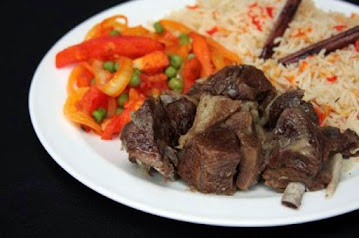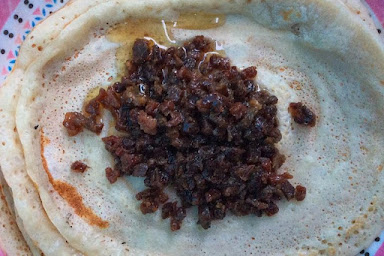
Somalia is a country located in the Horn of Africa, with a rich and diverse culinary history. Despite the challenges and conflicts the country has faced over the years, Somali cuisine has managed to maintain its unique identity, with its bold flavors, aromatic spices, and locally sourced ingredients.
One of the most famous dishes in Somali cuisine is Hilib Ari, a grilled or barbecued goat or lamb meat. This dish is often served during festive occasions and celebrations, and the meat is marinated in a mixture of spices and herbs before grilling it over an open flame. Hilib Ari is typically served with a side of rice, vegetables, or flatbread.

Another popular dish in Somali cuisine is Bariis Iskukaris, also known as Somali rice. This spiced rice dish is made with cumin, cardamom, cloves, and other aromatic spices, and often served with a meat or vegetable stew. Bariis İskukaris is a staple dish in Somalia, often served during special occasions and celebrations.

Suugo Suqaar is another favorite dish in Somali cuisine, a pasta dish made with vermicelli or spaghetti, and served with a tomato-based meat sauce. The meat is often diced into small pieces and cooked with onions, garlic, and various spices to create a rich and flavorful sauce. Suugo Suqaar is a simple yet hearty dish that is enjoyed by many Somalis and can be served with Banana.
Somali cuisine is also characterized by its use of spices and herbs, such as cumin, coriander, turmeric, cardamom, and cinnamon. These spices add depth and complexity to Somali dishes, creating a unique and flavorful fusion of different culinary traditions. Herbs such as cilantro, parsley, and mint are also frequently used to add flavor and aroma to dishes.
.jpg)
In addition to spices and herbs, Somali cuisine relies heavily on locally sourced ingredients such as meat, grains, and vegetables. Beef and goat meat are the most commonly consumed meats in Somalia, often prepared by grilling, stewing, or roasting. Rice, Maize, and Sorghum are the most commonly consumed grains, and they are often used to make bread, porridge, and other dishes. Vegetables such as tomatoes, onions, peppers, and eggplants are also widely used in Somali cuisine.
While bananas are not a primary ingredient in Somali cuisine, they are a popular and widely available fruit that is often used as a garnish or served as a dessert. Bananas are commonly sliced and added to dishes such as Suugo Suqaar or served on the side with a meal. They are also a common ingredient in desserts, such as banana fritters or banana bread. With their natural sweetness and versatility, bananas add a touch of sweetness to many Somali dishes and are a favorite ingredient among many Somali cooks.

Somali cuisine is a reflection of the country's rich history and diverse cultural influences. The coastal location of Somalia has influenced the cuisine with its reliance on seafood, while the country's proximity to Ethiopia has introduced the use of spices and herbs such as cumin and coriander.
Despite the challenges the country has faced, Somali cuisine has remained resilient, maintaining its unique identity and delicious flavors.So, the next time you're looking for a new and exciting culinary experience, consider trying the rich and flavorful dishes of Somali cuisine.



Comments
Post a Comment